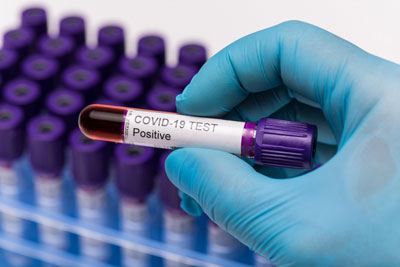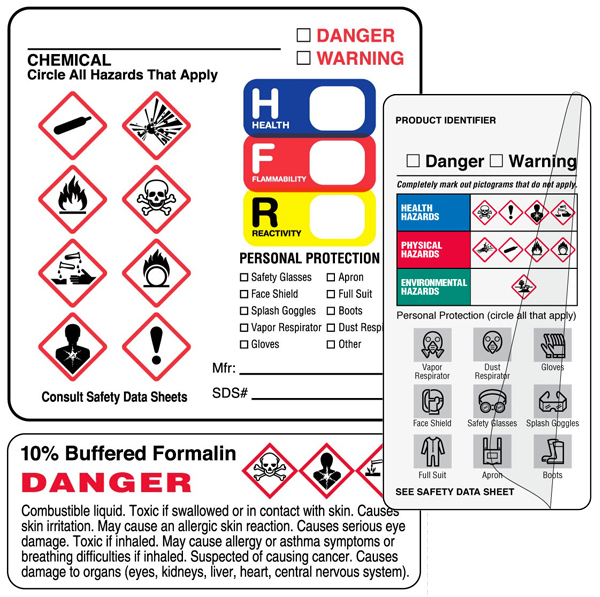Whether the test occurs in a hospital, commercial, private or academic lab, or a state testing facility, a COVID-19 specimen label is one of the required components. For example, once the healthcare worker extracts the tissue sample and places it into a sterile container, they apply a COVID-19 specimen label to the vial. The label contains patient identification information that ensures the test results get analyzed properly and communicated back to the patient in a timely manner.
COVID-19 Specimen Labeling Process
But, what happens if the label falls off or fails at some point in the testing process? An unlabeled sterile container will require repeating the test. Why would a label fail? Because the testing process contains complexities that require special label materials and adhesives.
To illustrate the process, when a patient visits a drive through testing site, they are met by a worker who verifies their ID, confirms the doctor’s orders and appointment time and asks how many people in the car will be getting tested. Then a label is printed for their sample(s) as the patient drives through to the next tent. There the healthcare worker swabs the back of the patient’s throat, or nasal cavity and places the swab in a sterile container, attaches the label to the vial and places it into a bio bag or other form of specimen transport for shipment to the lab.
With the exception of the car and tents, a hospital and other more formal laboratory settings use similar processes.
Once the specimen is shipped, it usually takes less than 24 hours for it to arrive at the lab. But longer delivery durations are possible depending on how far the hospital is from the processing lab. This can add additional complexities. In this situation, samples tested within 24 hours can be stored at room temperature. But, waiting times of 48 hours require refrigeration and 72 hours or longer require freezing.
Next, once the sample arrives at the actual test site, the barcode on the label is a key driver of patient information. For example, when a specimen is staged for analysis, the diagnostic system places it onto a conveyor where the vial passes through a barcode reader to record information about each sample. If the label is applied incorrectly or detaches during any previous step preventing a proper barcode reading, the system rejects it. Unfortunately, that usually requires the specimen to be redrawn.
Finally, once the lab analysis is complete, test results are sent back to the doctor for communication with the patient.
COVID-19 Labeling Requirements
Throughout the testing process, COVID-19 specimen labels must remain attached to the specimen. That may sound simple but it’s not, because the label must withstand these requirements:
- Remain flexible to fit around a small diameter vial without curling or popping
- Avoid sticking to examination gloves
- Withstand temperatures as low as 0℃
- Resist laboratory solvents such as xylene, dimethyl sulfoxide and isopropyl alcohol - without curling or defacing
- Withstand the polymerase chain reaction (PCR) process that determines whether the sample is positive or negative - without curling or defacing
- Retain the printed barcode and patient identification information without smearing
How To Ensure COVID-19 Specimen Labels Work Properly
Ensuring that COVID-19 specimen labels work properly requires a cooperative effort between the supply chain, healthcare workers and the label supplier. Following these steps will result in better outcomes:
- Work with a supplier that has label material expertise and experience with lab testing processes. For example, the UAL technical services team evaluates and tests materials for numerous applications and can recommend the best-fit options.
- Test the labels in current workflows - if possible. The urgency to ramp up testing and the manpower required to handle it may make this difficult. But, even labeling a few vials and simulating the workflow can help you avoid potential problems.
- Demonstrate proper labeling techniques - if possible. Healthcare workers may not understand how attaching the label to a vial can impact whether it stays attached or performs properly in subsequent steps. Because of work demands this may be difficult to facilitate but even a Zoom meeting or video that healthcare workers can review, that demonstrates best practices, will lead to fewer problems that can cause testing failures.
COVID-19 Specimen Labels At United Ad Label
As daily COVID-19 tests exceed 100,000 and with the belief of health officials that the number ultimately needs to reach at least 450,000, specimen labeling demands will continue to increase. Ensuring the labels work properly will help minimize the number of failed tests. With over 60 years of label manufacturing experience, United Ad Label works with healthcare organizations to provide reliable laboratory labels. Contact us to learn more.

